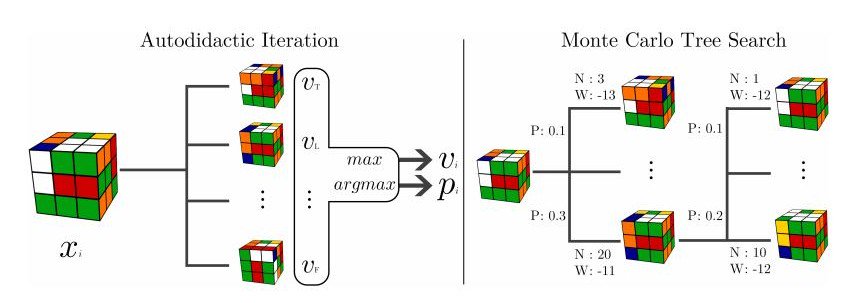
Computer programs have long been able to play chess; a relatively recently specialized platform from Deep Mind has even been trained
to play go . So professional that there are no players among people equal to computers, and most likely they will not.
The other day it became known that the machine independently learned how to solve another difficult puzzle - the Rubik's Cube. Moreover, when teaching, they did not demonstrate how to correctly assemble the die, the software platform created by scientists from the United States learned everything independently. Some experts believe that another “bastion that was considered a man’s possession” fell in front of the cars.
Rubik's cube, or rather, the algorithm of its assembly, is complicated by the fact that each action during assembly has certain consequences, but it is rather difficult to predict their effect on the overall assembly process. Even for the car. People usually learn to build a cube according to previously developed algorithms that allow solving a puzzle in the shortest possible time.
Some of the trainees are making amazing progress in this field. So, in May of this year
, another record was
set for assembling the Rubik's cube with two hands. The champion, a 22-year-old Australian named Felix Zemdegs, was able to assemble a cube in just 4.22 seconds. He began training at the age of 12, looking at the build entries on YouTube.
As for the machine, the robots collect the cube even faster. This year the record was set in 0.38 seconds. It could have been faster, but the mechanics of the cube itself could not stand. In an attempt to set a record, developers had to reinforce the cube design, otherwise it would simply fall apart from the machine’s too fast manipulations.
In the case of the platform referred to above, the work is carried out according to algorithms previously stored in the system memory. But scientists from MIT were able to train their own system to assemble the Cube independently.

When creating the cube itself by its inventor, the most interesting task was to develop a way to solve the puzzle from any position. Engineer Rubik managed to do it in a month. In the future, the assembly algorithm was repeatedly improved.
Recently, AI specialists began to look for a way to teach a car to add a cube. In the course went deep machine learning. The system was given the task and explained the rules. Next, the robot had to act independently. In the case of progress, the car received an award - something like this and teach weak forms of AI. After all, the computer must know that it is moving in the right direction. And he is given to understand this thanks to the reward system. All this helps the machine to learn.
In the case of the Rubik's Cube, this is somewhat more complicated than in the ordinary case. The fact is that until a certain point it is impossible to understand whether the system is working correctly or not. And there is no sense in rewarding for a random turn of the face that does not produce a result. In chess, everything is simpler - from the second or third turn, one can understand in which direction the game is moving and the machine works well or not. Accordingly, there is something to reward.
In order to teach the computer to add a Rubik's cube, a specialized technology of deep learning was used, which was called the “auto-didactic iteration”. This technology allows you to "unwind" the already assembled cube to achieve a configuration that is similar to the current one. It turns out something like reverse engineering, if this term is applicable to the training of machines. A specialized “decision tree” is created, which the machine uses to calculate the steps to each configuration.
The result was impressive. According to the developers themselves, the algorithm can solve the puzzle in about 30 moves. Moreover, the machine collects the cube in 100% of cases, whichever version of the disassembled puzzle it gets. In general, in order to assemble a well-fragmented puzzle, you need from 19 to 23 steps. Some solutions lead to the desired result faster than others. The fastest build algorithm consists of 21 steps.
The platform, developed by engineers MIT, called DeepCube. “Our platform is able to educate itself in a complex environment, receiving only one award for the entire process of work,” the report of the specialists says.
Now the same team of scientists is working on the implementation of their teaching method for solving other complex combinatorial problems. Among others - the prediction of the
tertiary structure of the protein .